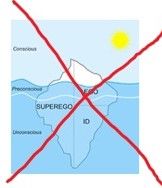Unconscious
Can You Have Two Thoughts at Once?
Do unconscious thoughts lurk below the surface, or is the surface all there is?
Posted November 2, 2019 Reviewed by Kaja Perina
Can you have two or more thoughts at once? Can you detect any thinking lurking below your immediate experience? Can you catch two completely different thoughts going on at the same time? You might like to delve into your own mind for a moment to find your own answers before I explain why I am asking.
The reason is that I and my daughter Emily were asked to review The Mind is Flat: The Illusion of Mental Depth and The Improvised Mind by psychologist Nick Chater – a rather fun request as he simultaneously had to review our book on consciousness.
His thesis is simple if stark; we find it hard to plumb our mental depths not because they are so deep and murky, but because there are no mental depths to plumb. All those popular ideas about the subconscious and the unconscious; hidden motivations, suppressed fears and buried hopes; lurking beliefs and desires – they are all false. We must abandon wholesale everything we think we know about the operation of our own minds, says Chater. In doing so we discover that the surface of the mind does not lie above a rich swirling mass of unconscious thought and action but that the surface – the ‘flat’ of the title – is all there is: ‘common-sense psychology isn’t true’. If we believe it, we are falling for ‘the illusion of explanatory depth’.
As if that is not dramatic enough, Chater goes on to propose his new theory of the ‘cycle of thought’. He notes that our brains need cooperation across a vast number of slow neural processing units, across whole networks or even entire regions of the brain. From here, he says, it is hard to see how so many interconnected neurons can coordinate on processing more than one thing at a time, and so he concludes that any given problem must be split into tiny fragments to be dealt with in parallel across the entire, densely interconnected network. This implies that the networks make one giant, coordinated step at a time, running at several beats per second. This he calls ‘the cycle of thought’.
The implication he draws is that any network can work on only one problem at a time so multi-tasking must be a rarity. Further, not only are we restricted to attending consciously to only one problem at a time, but we cannot, even unconsciously, be thinking about another. There can be no background processing or clever unconscious thoughts. In other words, we cannot have two thoughts at once.
Is this true? Again, I suggest you try the fun task of looking for your own answer. I tried to do this by paying attention to my own thinking. At first the answer seemed to be ‘no’; every time I caught a thought in progress it was overtaken by the observation ‘I was thinking about x but now I’m thinking about the question’. However, after some practice the answer seemed to be ‘yes’. For example, when cleaning my teeth and thinking about the structure of Internet memes, I had the thought that two minutes must be nearly up, and I turned on the tap. The thought about memes continued in parallel with this thought and action, apparently without pause. But perhaps the two alternated too rapidly for me to detect, leaving Chater’s claim intact.
Next, I tried deliberately creating two thoughts at once. For example, during a short Zen retreat, I went mindfully walking up a rough track on Dartmoor. I paid attention to the feeling of my feet walking while thinking about whether two thoughts are possible at once. This was easy, but I wondered whether simply observing my feet does not count as thinking, so next I counted my steps, still thinking about thinking. This, too, was easy but perhaps counting does not count as thinking either (though surely it should shouldn’t it?). Then suddenly I realised that the tune of ‘The holly and the ivy’ seemed to have been going on in my head for some time. I could remember the whole verse I’d been silently humming. Was this an unconscious thought continuing along with the counting and questioning?
Presumably Chater would dismiss this possibility as a post-hoc invention, although to me it seemed reasonable to think that the song had been provoked when I passed a large holly tree some minutes before. I imagine that if I’d not been doing this exercise the song would have been entirely forgotten.
Having concluded that many thoughts seemed to be going on at once I had to wonder what Chater counts as a thought. In fact, he says that all types of thought are extensions of perception so I think, on those grounds, all my thoughts during that walk would count. So that’s my answer. We can have two thoughts at once.
Actually, my own theorising about consciousness is just as counter-intuitive as Chater’s but in a

different way – I reject the idea that some thoughts are conscious, and others are not. Instead, I suggest that consciousness is an after-the-fact attribution we apply to some thoughts and not to others, not a fact about the thoughts themselves. This is closer to Dennett’s (1991) similarly counter-intuitive Multiple Drafts Theory. It seems to me that much scientific thinking about consciousness gets mired in the false assumption that some brain processes are conscious while others are not; some thoughts or perceptions are conscious while others are not. We need to replace this, I say, with the idea that we only call thoughts conscious when we connect them to a self-model and conclude that ‘I’ am (or was) conscious of this thought. All the time there are multiple thoughts going on; some get to have consequences for action and speech and end up being called conscious, but that’s just a label we give them. This approach is a completely different kind of illusionism from Chater’s and might potentially be tested against it by this question.
What do you think? Can we have two thoughts at once? I hope you have fun trying to find out for yourself.
References
Blackmore, S. and Troscianko, E.T. 2019 Out with Folk Psychology, In with What? Review of The Mind Is Flat by Nick Chater, American Journal of Psychology, 132:3, 369-374
Chater, N. 2018. The mind is flat: The illusion of mental depth and the improvised mind. Penguin
Chater, N. 2019 Consciousness Explored. Review of Consciousness: An Introduction (3rd Edition) by Susan Blackmore, Emily T. Troscianko, American Journal of Psychology, 132:3 (Fall 2019), pp. 374-378
Dennett, D.C. (1991) Consciousness Explained. London, Little, Brown & Co.


